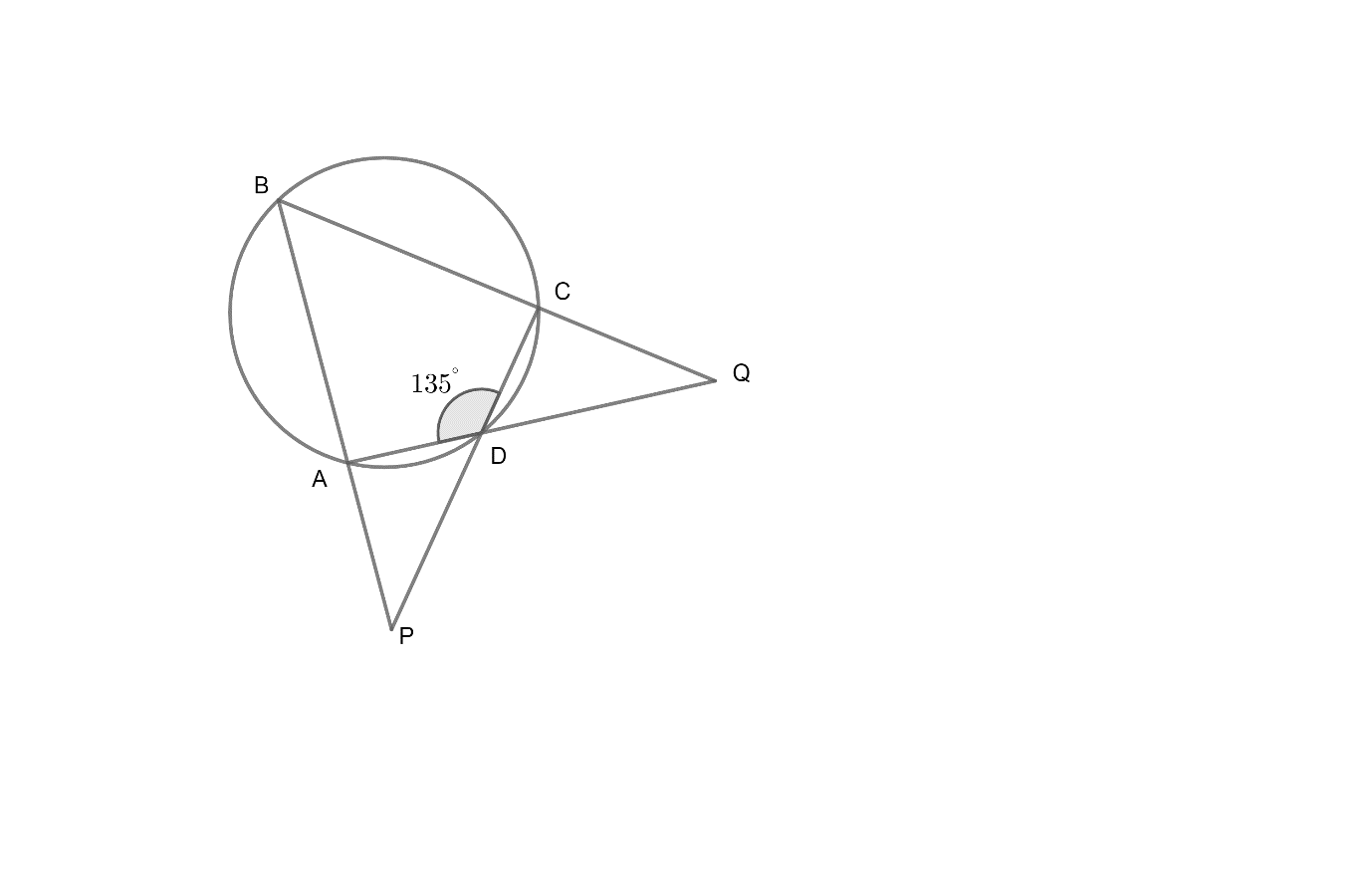
ABCD is cyclic quadrilateral with $\angle ADC=135{}^\circ $, sides BA and CD produced meet at point P, sides AD and BC produced meet at point Q. If $\angle P:\angle Q=2:1$, find angles P and Q.
Answer
596.7k+ views
Hint: In a cyclic quadrilateral the sum of opposite angles of the quadrilateral is always equal to $180{}^\circ $. Also, in any triangle the sum of its three angles is always equal to $180{}^\circ $.
Complete step-by-step answer:
An exterior angle of a triangle is equal to the sum of the opposite interior angles.

Given:
$P:Q=2:1$
Let the ratio constant be x
$\Rightarrow \dfrac{P}{Q}=\dfrac{2x}{1x}$
$\Rightarrow $ Hence, $\angle P=2x$, then $\angle Q=x$
Now, in cyclic quadrilateral ABCD,
Given, $\angle ADC=135{}^\circ $
From the property of cyclic quadrilateral (given in hint)
$\begin{align}
& \angle B=180{}^\circ -\angle ADC \\
& \Rightarrow \angle B=180{}^\circ -135{}^\circ \\
& \Rightarrow \angle B=45{}^\circ \\
\end{align}$
We know the sum of angles of a linear pair is equal to $180{}^\circ $.
Hence, $\angle ADC+\angle ADP=180{}^\circ $
$\begin{align}
& \Rightarrow \angle ADP=180{}^\circ -\angle ADC \\
& \Rightarrow \angle ADP=180{}^\circ -135{}^\circ \\
& \Rightarrow \angle ADP=45{}^\circ \\
\end{align}$
Now, in $\Delta AQB$,
From the property of sum of angles of a triangle (given in hint)
$\begin{align}
& \Rightarrow \angle A+\angle Q+\angle B=180{}^\circ \\
& \Rightarrow \angle A+x+45{}^\circ =180{}^\circ \\
& \Rightarrow \angle A=180{}^\circ -\left( x+45{}^\circ \right) \\
& \Rightarrow \angle A=\left( 135{}^\circ -x \right)...........\left( i \right) \\
\end{align}$
In $\Delta ADP$,
From exterior angle property of triangle (given in hint)
Exterior angle $A=\angle ADP+\angle P$
$\angle A=45{}^\circ +2x.........\left( ii \right)$
Equating (i) and (ii), we get,
$\Rightarrow 45{}^\circ +2x=135{}^\circ -x$ (Taking terms of x to one side)
$\Rightarrow 3x=135{}^\circ -45{}^\circ $
$\Rightarrow 3x=90{}^\circ $ (Dividing both sides of equation by 3)
$\Rightarrow x=30{}^\circ $
Hence, $\angle Q=30{}^\circ $
$\angle P=2x=60{}^\circ $
Note: In this question, it is very important to draw a rough diagram before solving. In this question the relation between $\angle P$ and $\angle Q$ is given. We need to be careful while choosing the triangles. Therefore, we will choose $\Delta ABQ$ and $\Delta APD$ to apply Angle Sum Property and Exterior Angle Property in these triangles respectively to establish an equation to get the ratio constant.
Complete step-by-step answer:
An exterior angle of a triangle is equal to the sum of the opposite interior angles.

Given:
$P:Q=2:1$
Let the ratio constant be x
$\Rightarrow \dfrac{P}{Q}=\dfrac{2x}{1x}$
$\Rightarrow $ Hence, $\angle P=2x$, then $\angle Q=x$
Now, in cyclic quadrilateral ABCD,
Given, $\angle ADC=135{}^\circ $
From the property of cyclic quadrilateral (given in hint)
$\begin{align}
& \angle B=180{}^\circ -\angle ADC \\
& \Rightarrow \angle B=180{}^\circ -135{}^\circ \\
& \Rightarrow \angle B=45{}^\circ \\
\end{align}$
We know the sum of angles of a linear pair is equal to $180{}^\circ $.
Hence, $\angle ADC+\angle ADP=180{}^\circ $
$\begin{align}
& \Rightarrow \angle ADP=180{}^\circ -\angle ADC \\
& \Rightarrow \angle ADP=180{}^\circ -135{}^\circ \\
& \Rightarrow \angle ADP=45{}^\circ \\
\end{align}$
Now, in $\Delta AQB$,
From the property of sum of angles of a triangle (given in hint)
$\begin{align}
& \Rightarrow \angle A+\angle Q+\angle B=180{}^\circ \\
& \Rightarrow \angle A+x+45{}^\circ =180{}^\circ \\
& \Rightarrow \angle A=180{}^\circ -\left( x+45{}^\circ \right) \\
& \Rightarrow \angle A=\left( 135{}^\circ -x \right)...........\left( i \right) \\
\end{align}$
In $\Delta ADP$,
From exterior angle property of triangle (given in hint)
Exterior angle $A=\angle ADP+\angle P$
$\angle A=45{}^\circ +2x.........\left( ii \right)$
Equating (i) and (ii), we get,
$\Rightarrow 45{}^\circ +2x=135{}^\circ -x$ (Taking terms of x to one side)
$\Rightarrow 3x=135{}^\circ -45{}^\circ $
$\Rightarrow 3x=90{}^\circ $ (Dividing both sides of equation by 3)
$\Rightarrow x=30{}^\circ $
Hence, $\angle Q=30{}^\circ $
$\angle P=2x=60{}^\circ $
Note: In this question, it is very important to draw a rough diagram before solving. In this question the relation between $\angle P$ and $\angle Q$ is given. We need to be careful while choosing the triangles. Therefore, we will choose $\Delta ABQ$ and $\Delta APD$ to apply Angle Sum Property and Exterior Angle Property in these triangles respectively to establish an equation to get the ratio constant.
Recently Updated Pages
Master Class 10 General Knowledge: Engaging Questions & Answers for Success

Master Class 10 Science: Engaging Questions & Answers for Success

Master Class 10 Social Science: Engaging Questions & Answers for Success

Master Class 10 Maths: Engaging Questions & Answers for Success

Master Class 10 English: Engaging Questions & Answers for Success

Master Class 10 Computer Science: Engaging Questions & Answers for Success

Trending doubts
Why is there a time difference of about 5 hours between class 10 social science CBSE

Write a letter to the principal requesting him to grant class 10 english CBSE

What is the median of the first 10 natural numbers class 10 maths CBSE

The Equation xxx + 2 is Satisfied when x is Equal to Class 10 Maths

Which of the following does not have a fundamental class 10 physics CBSE

State and prove converse of BPT Basic Proportionality class 10 maths CBSE




